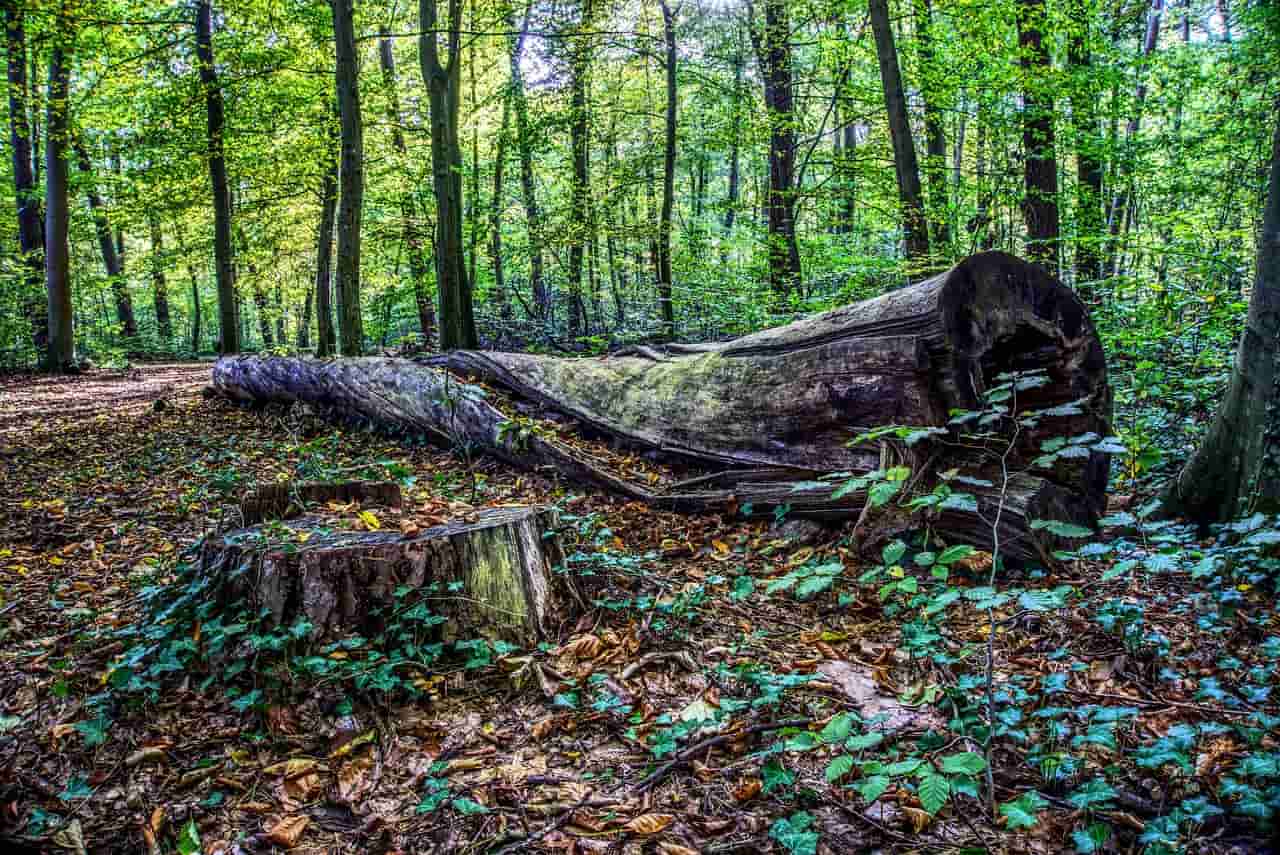When homeowners remove a tree from their property, they’re often left wondering what to do with the remaining stump.
Many people assume that nature will take its course, and the stump will simply disappear over time.
While this natural decay process does occur, understanding the timeline and factors involved can help property owners make informed decisions about stump management.
Tree stump decomposition is a fascinating biological process that transforms solid wood into organic matter through natural breakdown mechanisms.
The decomposition timeline varies significantly based on multiple environmental and biological factors, ranging from just a few years for certain softwood species to several decades for hardy hardwood stumps.
The natural rot process involves complex interactions between fungi, bacteria, moisture, and environmental conditions.
During this decomposition process, wood structure gradually weakens as microbial activity breaks down the cellular components. Understanding this decay cycle helps homeowners set realistic expectations for stump removal through natural means.
Most stumps will show visible signs of decay within the first few years, but complete decomposition can take anywhere from 3 to 30 years, depending on various factors.
The stump lifespan depends heavily on the original tree species, climate conditions, and the soil environment surrounding the remaining wood.
What Affects Tree Stump Rot?
Several key factors influence how quickly a stump will naturally decompose. These variables work together to either accelerate or slow down the biological breakdown process.
1. Type of Tree
The tree species plays a crucial role in determining the decomposition rate. Softwood trees like pine, fir, and cedar typically break down much faster than their hardwood counterparts.
Softwood stumps often begin showing significant decay within 3-5 years due to their less dense wood type and lower natural resistance to fungal growth.
Hardwood stumps from oak, maple, hickory, and similar species present a different challenge. These rot-resistant trees can maintain their structural integrity for 10-30 years or more.
The dense wood structure of hardwood species creates a more challenging environment for fungi and bacteria to establish themselves and begin the decay process.
Tree age at the time of removal also influences stump aging patterns. Older trees often have more developed heartwood, which can be more resistant to decomposition than younger wood.
However, older stumps may also have existing fungal infections or damage that can accelerate the rotting process.
2. Environment Around the Tree Stump
Environmental conditions significantly impact stump deterioration rates. Moisture levels play perhaps the most critical role in the decomposition process.
Wet soil conditions create an ideal environment for fungi and bacteria to thrive, accelerating wood breakdown. Conversely, dry conditions can slow decay by limiting the microbial activity necessary for decomposition.
Climate affects the overall stump environment in multiple ways. Regions with consistent moisture and moderate temperatures provide optimal conditions for fungal decomposition. Areas with extreme temperature fluctuations or prolonged dry periods may experience slower decay rates.
Soil conditions surrounding the stump influence the types and abundance of microorganisms available to break down the wood.
Rich, organic soils typically support more diverse bacterial populations and stump fungi, leading to faster decomposition. Poor or acidic soils may limit microbial diversity and slow the natural breakdown process.
Weather effects, including seasonal temperature changes, rainfall patterns, and humidity level,s all contribute to the stump’s exposure to decomposition-friendly conditions.
Stumps in shaded areas may retain moisture longer, while those with significant sun exposure might dry out more quickly.
The presence of other organic matter and insect activity in the surrounding area can also influence decay speed.
Termites, carpenter ants, and other insects in wood help break down cellular structures, creating entry points for fungi and bacteria to establish themselves within the stump.
Potential Damage of Tree Stump Rot
While natural stump decay might seem like a passive, harmless process, it can create several problems for property owners.
Understanding these potential issues helps homeowners decide whether to wait for natural decomposition or pursue active stump removal.
As stumps undergo the decay cycle, they can become breeding grounds for various pests. Fungal growth within decaying wood creates attractive habitats for insects, including termites that might eventually spread to nearby structures.
The soft, rotting wood provides ideal conditions for carpenter ants and other wood-boring insects to establish colonies.
Stump fungus and mycelium growth can spread to other organic matter in the landscape, potentially affecting nearby healthy trees or plants.
Some fungal species that thrive in decaying stumps can become problematic for surrounding vegetation.
The decomposition timeline creates ongoing landscape challenges. Partially decayed stumps can pose tripping hazards and make lawn maintenance difficult.
As the wood structure weakens, stump collapse can occur unexpectedly, creating depressions in the landscape that require filling and repair.
Stump shrinkage during the rotting process can affect surrounding soil stability and drainage patterns.
Root rot extending from the decaying stump can impact nearby plantings and create underground voids as root systems decompose.
How to Accelerate Tree Stump Rot
Property owners who want to speed up the natural decay process have several options available.
These methods work by enhancing the conditions that promote microbial activity and fungal decomposition.
Chemical treatment options can significantly reduce stump lifespan. Nitrogen fertilizer applied to the stump surface provides nutrients that encourage bacterial growth and accelerate wood breakdown.
The fertilizer creates a more favorable environment for decomposition-promoting microorganisms.
Epsom salt represents another chemical approach to stump treatment. When applied regularly, it helps draw moisture from the wood while providing minerals that certain decay-promoting organisms require.
This method works gradually but can reduce the decomposition timeline by several years.
Creating optimal moisture conditions speeds up the biological breakdown process. Keeping stumps consistently moist through regular watering or covering with mulch helps maintain the wet conditions that fungi and bacteria need to thrive.
A stump cover made from tarps or plastic sheeting can help retain moisture while protecting the area from sun exposure that might dry out the wood.
Mechanical methods can also accelerate stump aging. Drilling holes into the stump creates additional surface area for moisture penetration and provides entry points for microorganisms.
These holes can be filled with fertilizer or other amendments to further promote decay.
Adding organic matter around the stump creates a rich environment for decomposition organisms.
Compost, leaf mold, or other organic materials provide food sources for the microbes responsible for wood breakdown, potentially accelerating the overall process.
Trust a Professional
While natural stump decomposition offers an eco-friendly removal approach, it’s not always the most practical solution for every situation.
Professional stump removal services provide alternatives that can address property owners’ needs more efficiently.
Stump grinding represents the most common professional approach to stump removal. This mechanical grinding process removes the visible portion of the stump and major root systems within hours rather than years.
Professional equipment can handle stumps of any size and species, regardless of their natural decay resistance.
Manual removal techniques used by professionals can extract the entire stump and root systems when necessary.
This comprehensive approach eliminates any future decomposition concerns while preparing the area for immediate replanting or landscaping.
Professional services also offer chemical treatment options that work faster and more effectively than DIY approaches.
These treatments are applied by trained technicians who understand proper application rates and safety procedures.
Stump clearing professionals can assess individual situations and recommend the most appropriate removal method based on stump size, location, surrounding landscape features, and property owner priorities.
They can also handle the resulting stump mulch or debris in environmentally responsible ways.
Take Action
Understanding the natural decomposition process helps property owners make informed decisions about stump management.
While organic decay offers an environmentally friendly approach, the extended timeline and potential complications make it impractical for many situations.
Property owners should evaluate their specific circumstances, including landscape goals, safety concerns, and timeline requirements, when deciding between natural decomposition and active removal methods.
Consulting with tree care professionals can provide valuable insights into the best approach for individual situations.
Whether choosing natural decay or professional removal, taking action to address tree stumps prevents potential problems and maintains property aesthetics and functionality.
The key is selecting an approach that aligns with both immediate needs and long-term landscape goals.

